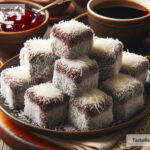The Story of the Australian Damper: A Bread for the Bush
Australia is a land of great natural beauty, unique animals, and some pretty remarkable history. It’s a place known for kangaroos, the Great Barrier Reef, and its rugged outback—the vast, remote areas that show off the country’s wild heart. But do you know about Australian damper, the famous bush bread? This simple yet iconic food has been part of Australian life for hundreds of years. Let’s dive into the story of the damper and why it holds a special place in the nation’s heart.
What is Damper?
Damper is a type of bread, but don’t expect soft slices like the ones at your local grocery store. It’s a dense bread made with just a few basic ingredients: flour, water, and salt. It doesn’t require yeast or fancy equipment to make, which is why it became so popular among Australian settlers, workers, and travelers in the bush.
Damper is traditionally baked in the hot ashes of a campfire, giving it a crusty outside and a hearty inside. It’s a simple, filling food that can keep you going during long days exploring or working in the outback.
Where Did Damper Come From?
The origins of damper are closely tied to Australia’s colonial history. When European settlers arrived in Australia in the late 18th century, they brought with them European farming practices and recipes. Bread, of course, was a staple food. But in the harsh, remote areas of the Australian countryside, settlers had to adapt. They didn’t always have access to ovens, yeast, or other ingredients, and they needed something easy to cook over a campfire while traveling.
The damper was born out of necessity. It was a simple solution to a big challenge: how to make bread with limited supplies and equipment. According to popular belief, the name “damper” comes from the idea of “damping down” the fire before baking the dough in the ashes.
Damper’s simplicity made it a perfect fit for the country’s early settlers, and it became closely linked to Australian bush culture.
The Role of Stockmen and Swagmen
Damper didn’t just feed settlers; it also played a big role in the lives of stockmen and swagmen. Stockmen were workers who looked after livestock, often spending weeks or months out in the vast countryside, far from civilization. Swagmen were travelers or laborers who wandered from place to place, carrying their belongings in a “swag,” a kind of rolled-up bundle. Both stockmen and swagmen often relied on campfire cooking, making damper an essential part of their diet.
With only basic supplies in their packs, these workers had to make do with what they had. Flour, water, and salt were easy to carry and store, and making damper required no special skills or equipment. For stockmen and swagmen, damper wasn’t just food—it was survival.
Over time, the damper became a symbol of life in the bush, representing the hard work and resilience of those who lived and traveled in Australia’s remote regions.
A Culinary Connection to Aboriginal Culture
It’s important to note that while European settlers popularized damper, the idea of a simple bread made in the bush wasn’t new in Australia. Aboriginal Australians had been making bush bread long before Europeans arrived. Using native seeds, grains, and nuts, Aboriginal women ground them up to make flour, which was then mixed with water and cooked on hot ashes. This traditional bread-making method is thousands of years old.
While the damper we know today differs from Aboriginal bush bread, it’s fascinating to see how early food traditions shaped how people adapted to Australia’s environment. The simplicity and resourcefulness of damper reflect the same qualities that Aboriginal bread-making demonstrates.
How Damper is Enjoyed Today
While damper started as a necessity, it has evolved into a beloved Australian tradition. Nowadays, people don’t need to camp out in the bush to enjoy damper—they make it at home or prepare it while camping for fun.
Damper recipes have also become more creative over time. Many people add ingredients like butter, sugar, milk, or beer to change the flavor or texture. Some even bake damper with cheese, herbs, or honey for a fancy twist. But whether you stick with the simple original recipe or experiment with fancy ingredients, a freshly baked damper always pairs perfectly with a cup of tea or a spread of butter and golden syrup.
Damper is also celebrated at festivals, gatherings, and bush-themed events, showing how this humble bread remains a big part of Australia’s identity.
Why Damper Matters
Damper may be a simple food, but its story tells us a lot about life in Australia. It represents the ingenuity of settlers and bush workers, the creativity of Aboriginal food traditions, and the resilience it took to survive in remote and harsh environments. Today, damper continues to connect Australians to their history and culture.
So, the next time you enjoy this iconic bread—whether it’s at a cozy campfire or in the comfort of your home—take a moment to appreciate its rich story. Damper is more than just bread; it’s a hearty slice of Australian heritage.
Closing Thoughts:
Australia’s damper reminds us that sometimes the simplest things can have the greatest stories. From the campfires of bush workers to family gatherings today, this unpretentious bread has a way of bringing people together. Why not try making some damper yourself and taste a bit of history? You’ll quickly see why it’s been loved for generations.


